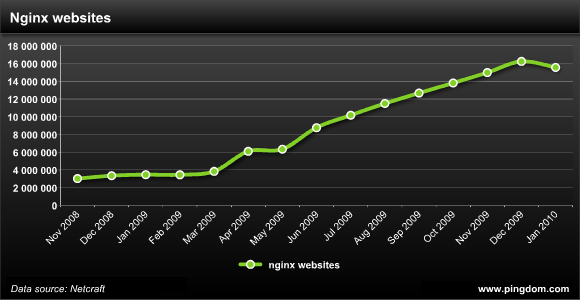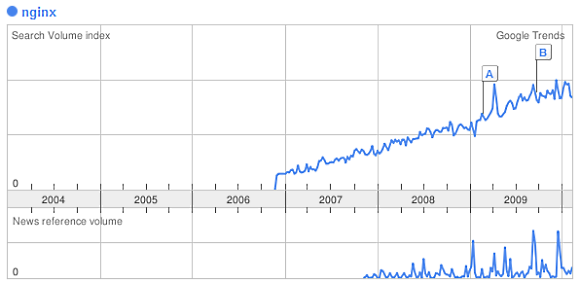
When it comes to web server software, Apache has been king of the hill for a long time. It currently has about 54% of the market. This is followed by Microsoft’s IIS, with about 24% of the market. Then, surprisingly, a new contender has started to rise, and it’s coming out of Russia: nginx (pronounced “engine x”).
According to Netcraft, 7% of all websites on the internet are now using nginx. This is all the more amazing when you consider that nginx was developed by just one person.
We have taken a closer look at this shooting star on the web server heavens and how fast it’s growing. We have also spoken directly with Igor Sysoev, its creator (Q&A further down), to get the inside scoop on what is happening with nginx right now.
What is nginx, and who uses it?
Nginx is a fast, light-weight web server that can also be used as a load balancer and caching server. It’s been written to be able to handle an extremely large number of simultaneous connections in a very efficient manner.
To be able to scale efficiently, nginx does things a bit differently than most web servers. For one, it doesn’t rely on threads to handle requests. Instead it uses a highly scalable asynchronous architecture which makes it possible for it to handle thousands of requests at once without using up a lot of system resources.
Nginx is free and open source, which has made it an easy option for those looking for a small, high-performance web server. It doesn’t necessarily have to be used on its own, and many sites use it together with for example Apache for specific tasks.
Nginx was developed by Igor Sysoev for use with one of Russia’s largest sites: Rambler (a web portal). He started developing the software in 2002, but the first public release wasn’t until 2004. The popularity of nginx has since exploded and it’s now used by millions of sites.
A few prominent sites that use nginx in one capacity or another are WordPress.com, Hulu, and SourceForge.
Rapid growth
Nginx has been growing consistently from year to year, and its momentum has been increasing. The number of websites using nginx grew by 384% in 2009 and 337% the year before that.
If you look at growth in terms of percent, nginx has been crushing every other web server out there.
In terms of absolute number of websites, nginx added 12.9 million websites in 2009. It even kept pace with Apache’s overall growth for most of the year, some months even surpassing it. As a comparison, Apache grew by 13.3 million websites in 2009.

In the above chart, the slump you see at the beginning of 2010 is apparently due to long-unused blogs being removed from WordPress.com and the Chinese 163.com.
Currently, just under 16 million websites are using nginx. If the yearly growth rate (in percent) remains the same in 2010 as in 2009, nginx will end up on more than 75 million websites by 2011. That would be an incredible feat, and although that prediction may be a bit optimistic, we would be highly surprised if nginx doesn’t grow significantly over the coming year.
Increasing buzz
Nginx isn’t just growing in terms of websites, the buzz around it is increasing as well.
If we use search volume on Google as an indicator for this, we see that searches for nginx have been rising steadily over time. It’s also been getting more and more news coverage, as you can see by the below Google Trends graph.

This increased interest in nginx is bound to feed on itself and as nginx gains more visibility, more people are likely to try it out.
Q&A with the author of nginx
To find out a bit more about what is going on with nginx, we spoke with its creator, Moscow-based Igor Sysoev. Sysoev currently works as a senior systems administrator at Rambler Media and was kind enough to answer our questions. (Warning, some tech geek speak ahead… 😉 )
Pingdom: How many developers are working on nginx?
Sysoev: I’m the only developer of nginx. There are also some patch contributors, the most active of them being Maxim Dounin. In addition to this, there are developers working on third-party modules.
Pingdom: What’s the most common use of nginx today?
Sysoev: I have no actual statistics, but I think it may be:
1) static files + proxying + cache
2) static files + FastCGI
3) load balance
3) only static files
Pingdom: How many use nginx as their main web server as opposed to a load balancer?
Sysoev: I don’t know, but I believe nginx is used more often as a proxy than as a main web server.
Pingdom: Why do you think nginx is growing so fast?
Sysoev: It’s really been a surprise to me.
I see several probable reasons for its rapid growth:
- First, it’s a free software. This is why it’s more popular than commercial servers such as Zeus and LiteSpeed.
- The nearest free competitor is lighttpd, but it seems that lighttpd stagnated in 2007-2008 and many lighttpd
users have switched to nginx. - Nginx got mentioned in printed books, mostly Ruby on Rails related.
Pingdom: What’s next for nginx?
Sysoev: Coming up next are backend interactions and cache improvements, refactoring of the rewrite module, and probably new embedded languages: javascript or lua.
Pingdom: Where do you think nginx will be in 5 years?
Sysoev: I really have no idea.
(We’d like to extend a big thank you to Igor Sysoev for taking the time to speak to us.)
Nginx in 2010 and onward
As large websites look for more efficient ways to handle their massive traffic, they are bound to start eyeing optimized solutions such as nginx to help them scale, just like Automattic has done with WordPress.com.
Nginx also has a growing community behind it, documentation in several different languages (originally this was a problem, because the documentation was at first only available in Russian). There’s even a helpful wiki with plenty of information and resources to help webmasters, sysadmins and web developers to get started.
We here at Pingdom suspect that nginx is marching into a very bright future.
Image credit: Nginx logo by Cliff Wells.


























